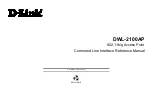
Chapter 4
|
Wireless Settings
Radio Settings
– 42 –
WMM Operation — WMM uses traffic priority based on the four ACs; Voice,
Video, Best Effort, and Background. The higher the AC priority, the higher the
probability that data is transmitted.
When the access point forwards traffic, WMM adds data packets to four
independent transmit queues, one for each AC, depending on the 802.1D
priority tag of the packet. Data packets without a priority tag are always added
to the Best Effort AC queue. From the four queues, an internal “virtual” collision
resolution mechanism first selects data with the highest priority to be granted a
transmit opportunity. Then the same collision resolution mechanism is used
externally to determine which device has access to the wireless medium.
For each AC queue, the collision resolution mechanism is dependent on two
timing parameters:
◆
AIFSN (Arbitration Inter-Frame Space Number), a number used to calculate
the minimum time between data frames
◆
CW (Contention Window), a number used to calculate a random backoff time
After a collision detection, a backoff wait time is calculated. The total wait time
is the sum of a minimum wait time (Arbitration Inter-Frame Space, or AIFS)
determined from the AIFSN, and a random backoff time calculated from a value
selected from zero to the CW. The CW value varies within a configurable range.
It starts at CWMin and doubles after every collision up to a maximum value,
CWMax. After a successful transmission, the CW value is reset to its CWMin
value.
Figure 30: WMM Backoff Wait Times
For high-priority traffic, the AIFSN and CW values are smaller. The smaller values
equate to less backoff and wait time, and therefore more transmit
opportunities.
AIFS
Random Backoff
AIFS
Random Backoff
CWMin
CWMax
CWMin
CWMax
Time
High Priority
Low Priority
Minimum Wait Time
Random Wait Time
Minimum Wait Time
Random Wait Time
Summary of Contents for SunSpot AC1200
Page 10: ...Tables 10...
















































